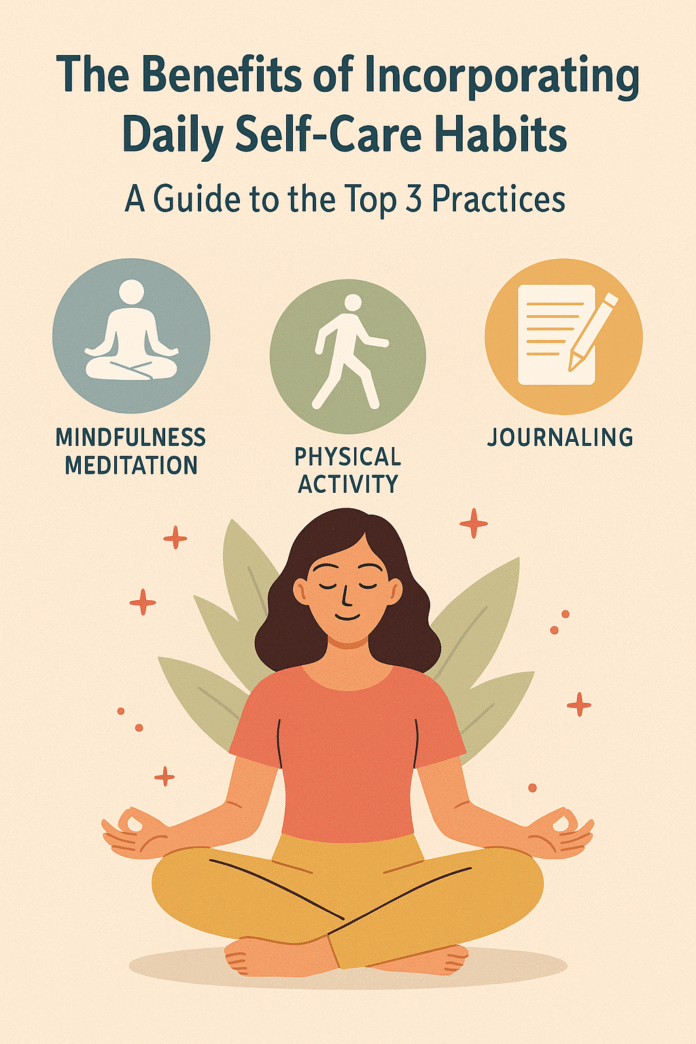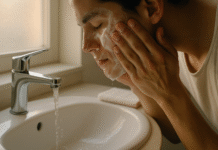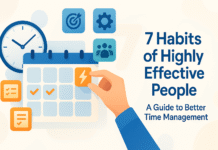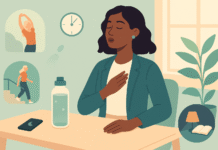Making time for self-care every day isn’t a luxury; it’s a need. In today’s fast-paced world, chronic stress, burnout, and mental fatigue are all too common. Adding simple, evidence-based self-care habits to your daily routine can greatly improve your health, make you more resilient, and make you more productive. Mindfulness meditation, exercise, and writing in a journal are the three most important self-care activities you can do every day. This guide goes into great detail about each of them. It talks about the science behind why they work, how to do them, and what their benefits are.
This article has
- Ways to put each practice into action
- Real-world examples and short case studies
- How to make habits and get past problems
- Questions that people have asked a lot based on what readers have said
- A reliable references section with working URLs
By the end, you’ll not only know what to do, but also why these habits are important and how to keep them going for the rest of your life.
Why you should take care of yourself every day
Deadlines, family obligations, and noise on social media are just a few of the problems that come up every day. Our mental, physical, and emotional reserves run out quickly if we don’t take care of ourselves on purpose. Taking care of ourselves is important, according to studies.
- Reduces stress hormones like cortisol, which helps with mood swings and long-term inflammation.
- It makes cognitive function better by improving memory, attention span, and decision-making.
- Increases resilience, which means you can recover from setbacks more quickly and are less likely to burn out.
Sarah, a 34-year-old marketing manager, saw that her mood changed a lot by noon. She said that after only 10 minutes of meditation in the morning, she had 40% fewer tension headaches and was able to concentrate better at work.
In the short term, a daily self-care habit can make you feel better and give you more energy. In the long term, it can make your immune system stronger and your relationships better.
The first thing to do is to practice mindfulness meditation.
What does it mean to meditate with mindfulness?
When you do mindfulness meditation, you pay close, non-judgmental attention to the present moment. You might do this by watching your breath, body sensations, or sounds. It is not the same as relaxation techniques because it does not try to get you to a certain state; instead, it makes you aware.
- Stress Reduction: Doing it regularly for 8 weeks can lower how stressed you feel by 30–40%.
- Relief from Anxiety and Depression: Clinical trials show that it works just as well as antidepressants for mild to moderate depression.
- It turns on parts of the prefrontal cortex that are linked to self-control and calms down the amygdala, which helps you control your emotions better.
How to Begin
- Set a Time: Try to do it for 5 to 10 minutes first thing in the morning or right before bed.
- Pick a position: sit up straight with your hands on your lap and your back relaxed. You can also meditate while walking or lying down.
- Be aware of how you breathe in and out. When your mind starts to wander, gently bring it back without judging it.
- Headspace (https://www.headspace.com) and Calm (https://www.calm.com) are two guided apps that offer structured programs for people who are new to meditation.
Habit Stacking: How to Keep Up with It
- Make meditation a part of something you already do, like brushing your teeth.
- Accountability Partner: Tell a friend what you want to do and then check in with them once a week.
- Keep track of your progress: Use a simple tracker or habit-tracking app to see how long you’ve been doing something.
Practice #2: Work out every day
Why it’s good for you to move around
Being active is important for more than just losing weight. It’s also good for your mental and emotional health. A brisk walk or a short yoga session are examples of moderate exercise that releases a lot of endorphins, neurotrophic factors, and blood flow.
Key Benefits:
- Walking quickly for 30 minutes can make you feel better for up to 12 hours and lower your anxiety.
- Exercise increases brain-derived neurotrophic factor (BDNF), which helps the brain change.
- Better Sleep Quality: Moderate daily activity can cut insomnia symptoms in half.
Routines that work every day
- In the morning, stretch and walk: Do some stretching for 10 minutes, then walk around your neighborhood for 15 minutes.
- Take a break from work every hour and do 5 to 10 squats or march in place for 5 minutes.
- Do 20 minutes of yoga or Pilates after work to help your muscles relax.
Getting Over Common Problems
- Time Limits: Do short workouts of 5 minutes or less throughout the day to break up your activity.
- Not feeling like doing it? Take a group class or a virtual challenge. Being around other people will help you stick with it.
- Talk to a doctor about personalized routines if you have physical limitations. Chair yoga or water aerobics are gentler options.
Writing in a journal to think about things is the third practice.
The Science of Writing It Down
Writing in a journal, whether it’s structured or free-form, helps you get your thoughts out of your head, which makes it easier to see patterns and what makes you feel bad. Studies show that writing expressively for 15 minutes three to four times a week can:
- Reduce signs of depression by 25%.
- People with high blood pressure should lower their blood pressure.
- Lowering the expression of stress-related genes can help your immune system work better.
Different types of journaling
- Gratitude Journaling: Each morning, write down three things that make you happy.
- Reflective Journaling: Write about a hard time in your life, including what happened, how you felt, and what you learned.
- Goal-Setting Journal: Write down what you need to do every day or week to reach your long-term goals.
How to Make It a Routine
- Keep it simple: Even five bullet points a day can help you.
- Set aside time to journal at the same time and place every day.
- Use prompts: Apps like Promptly Journals (https://promptlyjournals.com) or printable prompt cards can help you get your thoughts going.
Putting the Three Practices into Your Life
Do all three of these things at once to get the most out of them:
- Practice at a Certain Time
Meditation for Mindfulness in the Morning
5 to 10 minutes of guided breath awareness - Take a break for lunch and some exercise.
Take a 10-minute walk or stretch. - Night Thinking about it
Keeping a journal
Writing about gratitude or reflecting for 5 to 10 minutes at any time
Meditation or Movement in Small Steps
Breathing breaks of one to two minutes or stretches at your desk
Tip: Use your phone or calendar to set reminders to practice until it becomes second nature.
Getting through tough times and staying motivated: boredom and plateaus
- Do your meditation differently, like a body scan or loving-kindness.
- Do a variety of physical activities, such as biking, hiking, and dancing.
- Try a new prompt for your journal every week.
Taking care of your time
- Take care of yourself while doing your daily tasks, like washing the dishes mindfully.
- Let other people do low-priority tasks so you can have time for yourself.
Inconsistency Slumps
- Write down your main reasons to remind yourself of your “why.”
- Reward yourself for small wins by treating yourself after a week of success.
A Real-Life Case Study
John’s Journey to a Healthy Work-Life Balance
The baseline is 45-hour workweeks, not enough sleep, and back pain that won’t go away.
10 minutes of meditation in the morning, 20 minutes of walking at lunch, and 10 minutes of journaling in the evening are all things that can help.
Outcome (12 Weeks):
- 60% drop in reported levels of stress
- 15 minutes less time to fall asleep
- A new sense of purpose and a better idea of what I want to do with my life
Frequently Asked Questions
- Do I have to do all three things every day?
No, start with one and make it a habit. Then add the next one. Combining all three will have synergistic effects over time. - What if I don’t come?
Don’t think that you have to do everything or nothing. The goal isn’t to be perfect, but to make progress. Try again the next day. - When will I start to see results?
A lot of people say their mood gets better in 1–2 weeks, but changes in their bodies, like sleep and inflammation, might take 6–8 weeks. - Can these things help with mental health issues like anxiety or depression?
They can help in addition to professional treatment, but they shouldn’t be used instead of medical advice. Talk to your doctor every time. - Do I need any special apps or tools?
No, you don’t need apps or journals; all you need is a quiet place and a notebook.
To sum up
Daily self-care isn’t something that everyone should do. It’s a collection of things you can use to look after yourself. By making mindfulness meditation, exercise, and journaling a regular part of your life, you can become stronger, clearer, and healthier. Take small steps at first, stick with them, and make each practice work for you. Over time, these daily habits will help you become your healthiest and happiest self.
References
- Harvard Health Publishing. “Mindfulness meditation may ease anxiety, mental stress.” Harvard Health, April 2021. https://www.health.harvard.edu/mind-and-mood/mindfulness-meditation-may-ease-anxiety-mental-stress
- American Psychological Association. “Mindfulness meditation: A Research Review.” APA, 2019. https://www.apa.org/monitor/2019/02/mindfulness-practice
- Mayo Clinic Staff. “Meditation: A simple, fast way to reduce stress.” Mayo Clinic, February 2022. https://www.mayoclinic.org/tests-procedures/meditation/in-depth/meditation/art-20045858
- Johns Hopkins Medicine. “Meditation programs for psychological stress and well-being.” JAMA Internal Medicine, 2020. https://pubmed.ncbi.nlm.nih.gov/24841023
- National Institutes of Health. “Physical activity guidelines.” NIH, 2018. https://www.nih.gov/health-information/physical-activity-guidelines
- Sleep Foundation. “Exercise and sleep.” SleepFoundation.org, 2020. https://www.sleepfoundation.org/physical-activity/exercise-and-sleep
- American Psychological Association. “Expressive Writing: Journaling for Health.” APA, 2018. https://www.apa.org/monitor/2018/05/expressive-writing
- Proceedings of the National Academy of Sciences. “Disclosure of traumas and immune response.” PNAS, 2016. https://www.pnas.org/content/113/39/10974




































